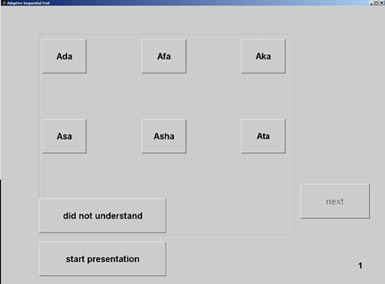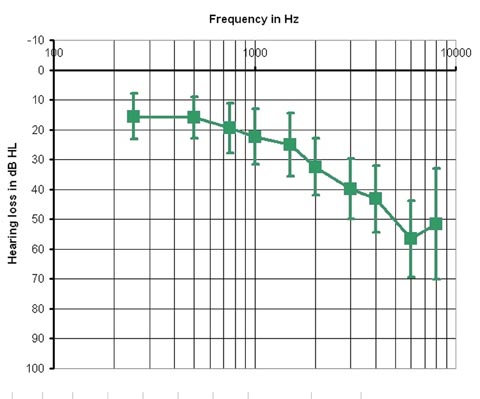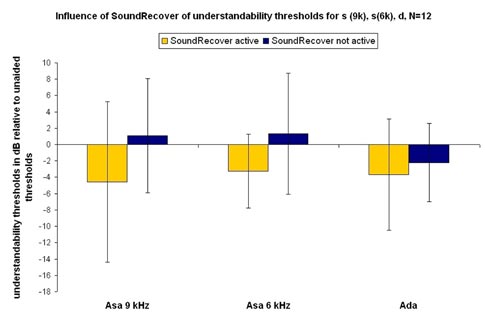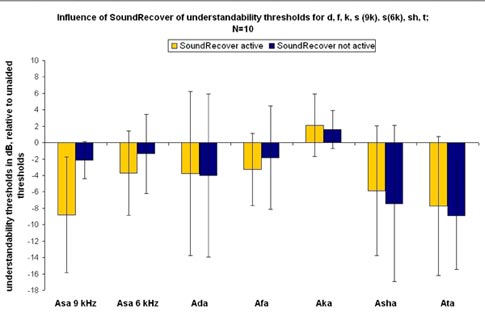Nonlinear frequency compression compensates for hearing loss in frequency ranges where traditional amplification on its own does not provide sufficient benefit.
The effectiveness of Phonak's proprietary nonlinear frequency compression algorithm, SoundRecover, has been documented for more significant degrees hearing loss (Simpson, Hersbach & McDermott, 2005, 2006;Nyffeler, 2008). The purpose of this study was to test whether SoundRecover provides sufficient benefit for people with mild to moderate hearing loss. Sufficient benefit is defined as whether the person can more easily recognize quiet, high frequency sounds. This study focused particularly on the /s/ sound. To measure consonant identification, a special test, the Adaptive Logatom Test, was designed that is sufficiently sensitive for cases of mild and moderate hearing loss (i.e. phonemes cannot be discerned on the basis of word or sentence context). The Adaptive Logatom Test was administered using adaptive control of the presentation level, and the respective identification thresholds of various consonants in nonsense syllables (logatoms) were recorded. The identification threshold of the /s/ sound clearly improved with SoundRecover. In addition, subjects reported that listening with SoundRecover was more pleasant than listening without it. A summary of this study was previously published in Phonak Field Study News (April 2009). This article provides the entire study, results and discussion.
Mild hearing loss and sounds from everyday life
Only approximately 15% of people with hearing impairment currently own hearing instruments (Karlsson & Rosenhall, 1998;Hanratty & Lawlor, 2000;Tomita, Mann, & Welch, 2001;Kochkin, 2007). Typically, the less severe the hearing loss, the less likely a person is to use amplification. One reason for this is people with milder hearing losses can, at least partially, compensate for the difficulties caused by the hearing loss. People with mild hearing impairment notice difficulty hearing primarily when trying to communicate in noisy or reverberant environments. In a quiet environment, on the other hand, someone with a mild hearing loss may only notice a small increase in difficulty communicating over people with normal hearing (Kiessling, 2006). Reduced audibility and discrimination of high frequency sounds are compensated for by inferring any missed words or sounds from the linguistic and situational contexts. The hearing loss may be noticed only in the case of passages with low predictability of individual sounds, such as unusual names or unknown abbreviations. Even in situations where speech has high sound predictability, however, mild hearing loss has its "costs";an increase in mental effort in trying to determine sounds, which leads to stress and fatigue.
SoundRecover
Hearing loss often manifests in the high frequencies. Recently, Phonak has developed SoundRecover, the non-linear, frequency-compression algorithm designed specifically for wearers who have difficulty hearing key high frequency speech sounds, such as the fricatives /f/, /s/, and /sh/. SoundRecover is a tool that improves the audibility of high frequency sounds where traditional amplification alone is not sufficient to increase audibility. This is the case if the wearer's hearing no longer offers sufficient resolution, or if not enough insertion gain from the hearing instruments can be offered for electro-acoustic reasons. The second case may occur with mild hearing loss when using an open fitting: insertion gain has to be accomplished in such a way that no internal hearing instrument circuit noise can be heard and no feedback occurs. Both issues would likely reduce acceptance of the hearing instrument by people with milder hearing impairments.
SoundRecover allows a portion of the incoming sound above a particular cut-off frequency to be compressed and shifted to lower frequencies. This means that, the higher above the cut-off frequency the individual frequency bands are, the farther they move into lower frequencies. For example, by setting the compression accordingly, the frequency of 9 kHz (where the maximum energy of a typical female /s/ lies) can be lowered to 6 kHz in order to establish greater audibility. No frequency changes are made for sounds below the cut-off frequency. The two relevant parameters of frequency compression are the cut-off frequency and the compression rate. With SoundRecover, these parameters are combined;the software calculates a setting recommendation using the audiogram that the professional can adjust or fine tune.
Question
The voiceless /s/ is the consonant of the Indo-European languages with the most high-frequency distribution of acoustic energy. For male speakers, it is usually between 4 - 6 kHz;for females speakers, it is typically between 6 - 10 kHz. While the /s/ for some male speakers is still within the transmission range of conventional hearing instruments, often the female /s/ cannot be made sufficiently audible with conventional amplification, especially when the voice is soft or distant. For this reason, the focus of the current study was on the benefits of SoundRecover when used with a mild hearing loss for identifying the /s/ sound from a female speaker.
Our central question was: Does SoundRecover help to improve the /s/ identification threshold in a quiet environment for people with a mild hearing loss? A positive answer would imply that it would be easier for people with mild hearing loss to understand speech passages with low sound predictability (e.g. unknown names, abbreviations). In addition, understanding speech passages with higher sound predictability may be less tiring. The effect of SoundRecover on the clarity and comfort of sounds experienced in the lab and in everyday living was also investigated.
Methodology
Adpative Logatom Test
In the case of mild hearing losses, conventional speech discrimination tests (word and sentence tests) often do not offer sufficient sensitivity to demonstrate hearing improvement with hearing instruments because single, nonrecognizable phonemes can be discerned in the context of the word or sentence. Discrimination tests that use nonsense syllables (logatoms) do not have this disadvantage. The Adaptive Logatom Test (Meisenbacher, 2008) based on the principle of the logatom test was used in this study.
The Adaptive Logatom Test is a phoneme test that uses the sounds "Asa", "Afa", "Asha", "Ada", "Ata", etc., as stimulus material. The only variable between stimuli is the middle consonant between the initial /a/ and final /a/ sounds.
The Adaptive Logatom Test used in this study contains these features.
- Consonant specificity of the stimulus material. The stimuli were established such that the medial consonant is the only acoustic variable between stimuli, and the features of the initial /a/ and final /a/ sounds do not serve as clues for the consonant. To achieve this end result, recordings of the enunciations of the stimuli must be as similar as possible across all stimuli, and sound engineering must ensure that initial /a/ and final /a/ are identical across stimuli. The speaker was therefore trained to use a consistent, tone, pitch, loudness, loudness progression and word length for each of the stimuli. In addition, the speaker listened to a looped presentation of a recording of "Asa" while presenting the other stimuli, to approximate "Asa" as closely as possible while presenting the other stimuli. Using sound engineering, the initial and final /a/ sounds of one recording of "Ama" served as the acoustically identical consonant transients between which the consonants /b/, /f/, /h/, /k/, /l/, /m/, /n/, /r/, /s/, /sh/, /t/, /w/ were placed by cutting, pasting and cross-fading. In the resulting stimulus set, the consonant-specific part of each stimulus included the consonant plus the adjacent transitions from the initial /a/ to the consonant and from the consonant to the final /a/.
- Stimulus-specific adaptive presentation level control. In the test, the presentation level of the individual stimulus ("Asa", "Afa," etc.) depends on the identification of the previous presentations of the stimulus. If the previous presentation was understood, the level is lowered for the next presentation. If the previous presentation was not understood or incorrectly understood, the level is raised. Level changes are successive -10, +5, -3, +2 dB. The simplest way to estimate the identification threshold is to use the average value of the last two level turning points. For each stimulus used in the test, there was a separate identification threshold.

Figure 1: Touch screen on which the test subject indicates which stimuli was heard during the Adaptive Logatom Test.
Two stimulus groups were used: Variation 1 contained the stimuli /d/, /s/ at 6 kHz and /s/ at 9 kHz. Variation 2 contained the additional sounds /f/, /k/, /sh/ and /t/. Both /s/ variants were meant to represent a typical female pronunciation and a truly deep female or high male pronunciation. The test subject heard the stimulus material in a sound-proof room via a loudspeaker at a distance of 1 m at 0° azimuth.
Clarity and Comfort of Sound Examples
In addition to measuring consonant identification, two additional methods were used in order to compare hearing with and without SoundRecover. In the lab, the test subject compared hearing with and without SoundRecover using a series of sound samples from everyday life: soft speech in a quiet environment, moderately loud speech in a quiet environment, loud speech in a noisy environment, moderately loud speech in a noisy environment, loud music, and moderately loud music. Comfort and clarity of the sound samples were compared and rated separately.
Daily hearing log
For everyday hearing, the test subject was given a daily log with hearing tasks to perform. The subject was asked to determine, for a series of sounds that mainly emphasized speech intelligibility as well as music listening, whether hearing with or without SoundRecover (accessible via two manual programs) offers more clarity.
Test subjects
The 12 test subjects, experienced users as well as first-time users, had mild hearing loss, as can be seen in Figure 2. Variation 1 of the Logatom test was used for these 12 test subjects;variation 2, only for 10 test subjects.
Hearing aid and adjustment
Exélia Art hearing instruments were used to assess hearing and consonant identification with and without SoundRecover. The hearing instruments were coupled to the ear using a maximally opened sound tube. Prior to the tests with SoundRecover, the amplification and compression knee points in the high frequency channels (3.5 to 10 kHz) were adjusted so that the following conditions were met:
- maximum gain for 25 dB input in the high frequency channels
- no internal hearing instrument noise is perceived
- no feedback occurs
- high-frequency sounds at 50 dB were not perceived as too sharp;/s/ was not perceived as too sharp
- below 3.5 kHz, the insertion gain was set to zero

Figure 2: Average tone audiogram from the 12 test subjects with standard deviations.
Test design
Hearing with and without SoundRecover was the experimental independent variable. As a check, unamplified hearing was also tested. The identification thresholds of the individual consonants used in the Adaptive Logatom Test served as the dependent variable. In addition, the results of the clarity and comfort comparisons in the lab, and the results of the daily log were dependent variables.
Test sequence
- Lab appointment: Hearing instrument adjustment
- Two-week acclimatization phase and tasks performed as recorded in the daily log
- Lab appointment: First Adaptive Logatom Test measurement with variations 1 and 2
- Lab appointment: Second Adaptive Logatom Test measurement with variations 1 and 2. In addition, comfort and clarity comparison of SoundRecover ON vs. OFF using sound examples.
Figure 3 shows the results from variation 1 of the Adaptive Logatom Test. Identification thresholds are normalized to an unaided hearing level. SoundRecover clearly improved the identification threshold at 6 kHz for /s/ and 9 kHz for /s/. Negligible improvement was shown for the /d/ sound.

Figure 3: Average identification thresholds with and without SoundRecover for /s/ at 9 kHz, /s/ at 6kHz and /d/

Figure 4: Average identification thresholds with and without SoundRecover for /s/ at 9kHz, /s/ at 6kHz, /d/, /f/, /k/, /sh/, and /t/
Figure 4 shows the results from variation 2 of the Adaptive Logatom Test. For /k/, there were slightly worse but significant differences found of SoundRecover compared to unaided hearing. However, this was more than compensated for by the improvements for the /s/ sound as well as /d/, /f/, /sh/, and /t/ with the aid of SoundRecover. With variation 1, both /s/ sounds clearly showed the effectiveness of SoundRecover.
Between the first and second test measurements, there were no systematic differences, thus test and re-test validity was given. In addition to the effects of aided hearing and SoundRecover, the results reinforce the validity of the Adpative Logatom Test.
When comparing SoundRecover ON versus OFF during a series of everyday sound samples, there was no subjective difference in hearing clarity. However, for the hearing comfort comparison, SoundRecover showed a clear advantage.
Conclusion
The main purpose of this study was to examine the benefits of SoundRecover for subjects with a mild hearing loss. Further, with the Adaptive Logatom Test, a sensitive method to measure identification thresholds of high-frequency speech material has been developed. The findings of this study suggest that SoundRecover has the potential to provide substantial improvement in the acquisition and identification of high-frequency speech signals and environmental sounds when compared to conventional high-end digital amplification. In addition to the significant benefits of SoundRecover in test subjects with severe to profound hearing loss, Identification of /s/ sounds have been shown to improve with the use of SoundRecover in cases of mild hearing loss;even when the possibilities of conventional amplification have been fully exhausted. This suggests that understanding speech passages with low loudness predictability is improved since this study showed initial improvements in speech recognition for high-frequency weighted speech materials. Also, detection thresholds for high-frequency inputs were lower, which may result in improved audibility of high-frequency consonants. This type of full-time access to input across the entire speech range is critical for the development of typical speech, language, and auditory skills. Further, test subjects subjectively perceived hearing with SoundRecover as more comfortable than without.
It is concluded that SoundRecover should be considered as an option for subjects with mild to moderately-severe hearing loss. The Adaptive Logatom Test is an important step in finding appropriate methods to evaluate the benefit of hearing instruments in treating mild hearing loss.
References
Bess, F.H. (1999). School aged children with minimal sensorineural hearing loss. Hearing Journal, 52, 10,12,14,16.
Bess, F.H., Dodd-Murphy, J., & Parker, R.A. (1998). Children with minimal sensorinaural hearing loss: prevalence, educational performance, and functional status. Ear & Hearing 19, 339-354.
Boretzki, M. & Kegel, A. (2009, April). The benefits of SoundRecover for mild hearing loss. Phonak Field Study News. StafÓ", Switzerland: Phonak.
Burgener, G.W. & Mouw, J.T. (1982a). Minimal hearing loss effect on academic/intellectual performance of children. Study 1. Hearing Instruments,33, 6-8,17.
Burgener, G.W. & Mouw, J.T. (1982b). Minimal hearing loss effect on academic/intellectual performance of children. Study 1. Hearing Instruments, 33, 8,14,16.
Crandell, C.C. (1993). Speech recognition in noise by children with minimal degrees of sensorineural hearing loss. Ear & Hearing, 14, 210-216.
Flexer, C. (1995). Classroom management of children with minimal hearing loss. Hearing Journal, 48, (10), 54-58.
Franks, J.R. & Beckmann, N.J. (1985) Rejection of hearing aids: attitudes of a geriatric sample. Ear and Hearing, 6(3),161-166.
Hanratty, B. & Lawlor, D.A. (2000). Effective management of the elderly hearing impaired - a review. Journal of Public Health Medicine, 22(4), 512-517.
Karlsson, A.K. & Rosenhall, U. (1998). Aural rehabilitation in the elderly: supply of hearing aids related to measured need and self-assessed hearing problems. Scandinavian Audiology, 27(3), 153-160.
Kiessling, J. (2006). Neue Aspekte zur Hörgeräteversorgung bei Lärmschwerhörigkeit [New aspects of hearing instrument supply for people with a noise-induced hearing loss]. HNO, 54, 573-582.
Kochkin, S. (2007). MarkeTrak VII: Obstacles to adult non-user adoption of hearing aids. Hearing Journal, 60(4), 24-51
Kricos, P.B., Lesner, S.A., & Sandridge, S.A. (1991). Expectations of older adults regarding the use of hearing aids. Journal of the American Academy of Audiology, 2(3), 129-133.
Meisenbacher, K. (2008). Entwicklung und Evaluation eines adaptiven Logatomtests zur Ermittlung der Konsonantenverständlichkeit [Development and evaluation of an adaptive phoneme test to determine the intelligibility of consonants]. Diplomarbeit Fachhochschule Oldenburg [Diploma Thesis, University of Applied Science], Oldenburg, Germany.
Meister, H., Lausberg, I., von Wedel, H., & Walger, M. (2004): Untersuchung von Faktoren bei der Erstversorgung mit Hörgeräten [Evaluation of important factors concerning a first fitting of hearing instruments]. HNO, 52, 790-797.
Nickisch, A. (2002, March). Versorgung minimaler Schallempfindungsstörungen bei Kleinkindern mit zusätzlichen Entwicklungsstörungen durch volldigitale Hörsysteme [Supply of digital hearing systems to infants with a minimal sound feeling disturbance and additional developmental disturbances]. DGA Jahrestagung.
Nyffeler, M. (2008, October 20). The Naída Power hearing instrument family - Field test results demonstrate better speech clarity - unparalleled in its class. AudiologyOnline, Article 2136. Direct URL: www.audiologyonline.com/articles/article_detail.asp?article_id=2136. Retrieved October 9, 2009 from the Articles archive on www.audiologyonline.com
Simpson, A., Hersbach, A.A. & McDermott, H.J. (2005). Improvements in speech perception with an experimental nonlinear frequency compression hearing device. International Journal of Audiology, 44(5), 281-92.
Simpson, A., Hersbach, A.A. & McDermott, H.J. (2006). Frequency-compression outcomes in listeners with steeply sloping audiograms. International Journal of Audiology, 45(11), 619-629.
Tomita, M., Mann, W.C., & Welch, T.R. (2001). Use of assistive devices to address hearing impairment by older persons with disabilities. International Journal of Rehabiltation Research, 24(4), 279-289.

